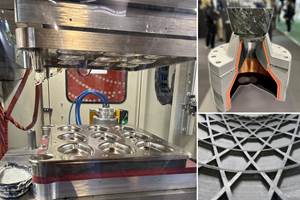Low-profile, high-performance manufacturer
Advanced Composite Products & Technology Inc. provides innovative and cost-efficient composite solutions to some of the most difficult and demanding real world applications.
Whether you are aware of this company, or not, Advanced Composite Products & Technology Inc. (ACPT, Huntington Beach, CA, US) says it thrives on providing innovative and cost-efficient composite solutions to some of the most difficult and demanding real world applications. Founded in 1977 by Dr. James C. Leslie and his son, James Leslie II, the company is involved in design, development and manufacturing of advanced composite applications for research, commercial, government, and private institutions, with an emphasis on filament winding. The market sectors that ACPT serves include space, aviation, defense, motorsports, marine, converting, heavy industry and drilling.
ACPT is located within what might be called the Huntington Beach composites cluster, in close proximity to at least six other composites companies. Like its neighbors, ACPT offers a wide range of in-house capabilities. It has a number of 4-axis CNC filament winders, the largest having a length of 11.1m or 36.2 ft, electronically-controlled tensioners and numerous curing ovens. Lamination-related equipment includes a clean room, vacuum mixer, bladder and trapped molding equipment, and a finishing area and paint booth. Ovens and autoclaves are on premises, as are hydraulic presses for compression molding and press-forming. A fully-staffed machine shop allows for grinding, drilling, milling and all other required finishing operations. The company conforms to its quality assurance management system and has been audited according to the requirements of AS 9100.
Over its 41 years of operation, ACPT has, rather than focusing on one business area, designed, prototyped and manufactured an array of unique parts for a diverse customer base, from low rate to full production. A sampling of parts includes but is not limited to aircraft ducting, satellite components, launch tubes and ordnance components, cryogenic tanks, radomes, UAV components, lightweight industrial converting rollers, automotive and industrial driveshafts and high-demand critical military applications. “While we can’t share specifics about our projects, one example I can mention was an early program with the US Department of Energy to develop offshore composite drill pipe. Since the completion of this program we have developed and commercialized various composite applications for the oil & gas industry,” says Jim Leslie.
To complete those projects, ACPT, like other composite manufacturers, partners with composite material suppliers. One of these is Magnolia Advanced Materials (Atlanta, GA, US, ), a supplier of a diverse card of materials, from epoxy resins and adhesives to coating and conductive materials, liquid shims, potting and encapsulating compounds, sealants and syntactics, tooling and casting resins, and finally, custom or toll formulating for specific requirements. Magnolia was an important supplier for a recent confidential project involving design and manufacture of a carbon fiber vehicle driveshaft. Leslie adds that the company uses thermoset resins combined with carbon, glass and aramid fibers for its projects. ACPT suppliers also include Mitsubishi Chemical Carbon Fiber & Composites Inc. (Irvine, CA, US), Toray Composites (America) Inc. (Tacoma, WA, US), Teijin Carbon America, Inc. (Rockwood, TN, US) and Composites One (Arlington, IL, US).
ACPT tells CW that it constantly implements continuous improvement methods and process controls throughout its business, and that it is devoted to investing a lot of resources in these areas including unlimited training for all employees. Although ACPT Inc. operates in stealth mode, this California company is well-positioned for the future. Visit for more information.
Related Content
Otto Aviation launches Phantom 3500 business jet with all-composite airframe from Leonardo
Promising 60% less fuel burn and 90% less emissions using SAF, the super-laminar flow design with windowless fuselage will be built using RTM in Florida facility with certification slated for 2030.
Read MoreThe potential for thermoplastic composite nacelles
Collins Aerospace draws on global team, decades of experience to demonstrate large, curved AFP and welded structures for the next generation of aircraft.
Read MoreJEC World 2024 highlights: Thermoplastic composites, CMC and novel processes
CW senior technical editor Ginger Gardiner discusses some of the developments and demonstrators shown at the industry’s largest composites exhibition and conference.
Read MoreWelding is not bonding
Discussion of the issues in our understanding of thermoplastic composite welded structures and certification of the latest materials and welding technologies for future airframes.
Read MoreRead Next
Ceramic matrix composites: Faster, cheaper, higher temperature
New players proliferate, increasing CMC materials and manufacturing capacity, novel processes and automation to meet demand for higher part volumes and performance.
Read MoreScaling up, optimizing the flax fiber composite camper
Greenlander’s Sherpa RV cab, which is largely constructed from flax fiber/bio-epoxy sandwich panels, nears commercial production readiness and next-generation scale-up.
Read MoreCutting 100 pounds, certification time for the X-59 nose cone
Swift Engineering used HyperX software to remove 100 pounds from 38-foot graphite/epoxy cored nose cone for X-59 supersonic aircraft.
Read More












